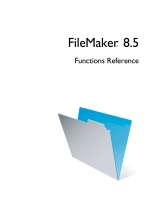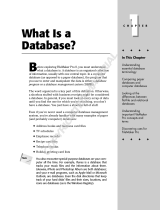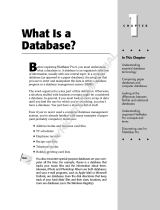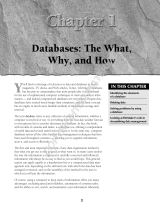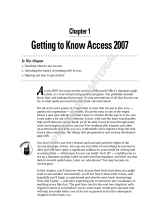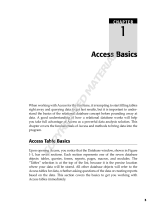Page is loading ...

FileMaker Pro 7
User’s Guide
TM

© 1995-2004 FileMaker, Inc. All Rights Reserved.
FileMaker, Inc.
5201 Patrick Henry Drive
Santa Clara, California 95054
FileMaker is a trademark of FileMaker, Inc., registered in the U.S. and other countries, and
ScriptMaker and the file folder logo are trademarks of FileMaker, Inc.
FileMaker documentation is copyrighted. You are not authorized to make additional copies
or distribute this documentation without written permission from FileMaker. You may use
this documentation solely with a valid licensed copy of FileMaker software.
All persons and companies listed in the examples are purely fictitious and any resemblance
to existing persons and companies is purely coincidental.
Credits are listed in the Acknowledgements document provided with this software.
For more information, visit our web site at www.filemaker.com.
Edition: 01A

Contents
Preface
Introducing FileMaker
Pro
Using this manual
7
Using FileMaker Pro documentation
7
Where to find PDF documentation
7
Online Help
8
Templates, examples, and more information
8
Suggested reading
8
FileMaker Pro overview
9
Creating simple or complex databases
9
Using layouts to display, enter, and print data
9
Finding, sorting, and replacing data
10
Protecting databases with accounts and privilege sets
10
Creating scripts to automate tasks
10
Sharing and exchanging data
11
Chapter 1
Using databases
About database fields and records
13
Opening files
14
Opening multiple windows per file
15
Closing windows and files
15
Saving files
16
When FileMaker Pro saves a file
16
About modes
17
Viewing records
17
Viewing records in table format
18
Selecting the active record
19
Moving through records
19
Adding and duplicating records
20
Adding and duplicating related records
20
Deleting records
21
Entering data
21
Selecting a field
21
Entering and changing data in fields
22
Finding records
23
Making a find request
23
Finding text and characters
24
Finding numbers, dates, times, and timestamps
25
Finding ranges of information
26
Finding data in related fields
27
Finding empty or non-empty fields
27
Finding duplicate values
27
Finding records that match multiple criteria
27
Finding records except those matching criteria
28
Deleting and reverting requests
29
Viewing, repeating, or changing the last find
29
Hiding records from a found set and viewing
hidden
records
29
Finding and replacing data
30
Sorting records
30
Previewing and printing databases
31
Previewing data on a layout
31
Printing records
32
Printing scripts
33
Printing table and field information
33
Printing the relationships graph
33
Automating tasks with scripts
34
Backing up database files
34
Setting preferences
34

4
FileMaker Pro User’s Guide
Chapter 2
Creating databases
Planning a database
35
Creating a FileMaker Pro file
38
Defining database fields
39
About naming fields
39
About choosing a field type
40
Defining text, number, date, time, timestamp, or
container
fields
41
Defining calculation fields
41
Defining
summary fields
43
Setting options for fields
44
Defining automatic data entry
45
Defining field validation
46
About storage and indexing options
47
Defining database tables
47
Creating layouts and reports
48
About layout types
49
Setting up a layout to print records in
columns
51
Working with objects on a layout
52
Selecting objects
53
Working with fields on a layout
54
Placing and removing fields on a layout
54
Deciding where to place related fields
55
About merge fields
55
Formatting field data on a layout
56
Allowing or preventing entry into fields
59
Working with parts on a layout
59
About layout part types
60
Chapter 3
Working with related tables and files
About relationships
61
Relational database terminology
63
About the relationships graph
64
About match fields for relationships
64
Types of relationships
64
Planning a relational database
68
Working with the relationships graph
68
Creating relationships
68
Changing relationships
69
Summarizing data in portals
70
About lookups
71
Creating lookups
71
Editing lookups
72
Chapter 4
Sharing and exchanging data
Sharing databases on a network
73
Enabling file sharing and hosting files
74
Opening shared files as a client
74
Closing a hosted file
75
Importing and exporting data
76
Supported import/export file formats
76
ODBC and JDBC
76
Methods of importing data into an existing file
76
About adding records
76
About updating existing records
76
About updating matching records
77
About the importing process
77
Converting a data file to a new FileMaker Pro file
78
About the exporting process 78
Publishing databases on the web 79

Contents 5
Chapter 5
Protecting databases with accounts and privilege sets
Protecting databases 81
Accounts, privilege sets, and extended privileges 82
About the predefined accounts 83
About the predefined privilege sets 83
Planning security for a file 84
Password-protecting a file 85
Creating accounts and privilege sets 85
Viewing accounts and privilege sets 86
Creating accounts 86
Creating accounts that authenticate via an external server 87
Creating privilege sets 88
Viewing extended privileges 89
Chapter 6
Converting FileMaker databases from previous versions
Conversion overview 91
Converting a single file 92
Converting multiple files at once 93
Reading the Conversion.log file 95
Solving basic conversion problems 95
Converting FileMaker Pro 1.x and 2.x databases 96
Top conversion issues 96
Passwords 96
Preserving user dictionary information 96
Print Setup script step stored setup options (Windows) 97
Switching windows in scripts 97
Boolean functions and find requests 97
File references 98
Index 99

6 FileMaker Pro User’s Guide

Preface
Introducing FileMaker Pro
FileMaker
®
Pro
is the leading workgroup database software for
quickly creating and sharing solutions adapted to your business
needs. Powerful features, broad platform support, and an easy-to-use
interface make FileMaker
Pro indispensable for anyone who needs
to track and manage people, projects, and information.
Using this manual
This User’s Guide contains an introduction to FileMaker Pro
features and provides step-by-step instructions on the most common
FileMaker
Pro tasks. You may need to refer to FileMaker Pro Help
for detailed information on more advanced product features.
Using FileMaker Pro documentation
The FileMaker Pro documentation provides a learning path to
productivity, installation instructions, a tutorial to get you started,
online Help, and more.
The following manuals are included:
1 FileMaker Pro User’s Guide (this manual): contains key concepts
and basic procedures
1 Installation and New Features Guide for FileMaker Pro and
FileMaker Developer: contains installation instructions and new
features information
1 FileMaker Pro Tutorial: contains lessons that teach you how use
the major features of FileMaker
Pro
1 FileMaker Instant Web Publishing Guide: describes how to make
FileMaker
Pro databases accessible to web browser users over an
intranet or the Internet
1 Converting FileMaker Databases from Previous Versions:
contains information about converting databases from previous
versions to FileMaker Pro 7 format
1 Customizing the FileMaker Pro Templates: describes how to
customize the included database template files for your own needs
1 FileMaker Security Guide: describes security concerns to keep in
mind when using FileMaker products
1 Installing FileMaker ODBC and JDBC Client Drivers: describes
how to install driver files for using FileMaker Pro with ODBC and
JDBC applications
1 FileMaker ODBC and JDBC Developer’s Guide: describes how to
use ODBC and JDBC with FileMaker products
Where to find PDF documentation
Most PDF manuals are located in the folder where you installed
FileMaker Pro. If you installed FileMaker Pro in the default folder
location, the PDF manuals are located here:
Windows: C:\Program Files\FileMaker\FileMaker Pro 7\English
Extras\Electronic Documentation
Mac OS: Macintosh HD/Applications/FileMaker Pro 7/English
Extras/Electronic Documentation
To view the PDF files, you need a PDF reader. In Mac OS X, you can
use either the built-in Preview application or Adobe Reader.
Windows users need Adobe Reader. If you do not have Adobe
Reader, you can download it from the Adobe web site at
www.adobe.com.
Important You can download PDFs of FileMaker 7 documentation
from www.filemaker.com/downloads. Any updates to this document
are also available from the web site.

8 FileMaker Pro User’s Guide
All of the PDF files use the tagged Adobe Portable Document format
(PDF). Tagged PDF files work with assistive technology such as the
screen readers JAWS for Windows and Window-Eyes. For more
information about tagged PDF files, see the Adobe web site at
www.adobe.com.
Online Help
FileMaker Pro Help provides comprehensive step-by-step
instructions on FileMaker Pro features. You can open Help from the
Help menu in FileMaker Pro.
There are three ways to access Help:
1 Browse the Help table of contents to locate topics by subject.
1 Search for particular topics by entering keywords.
1 Get information about the currently displayed dialog box by
pressing F1 (Windows) or 2-? (Mac OS).
Templates, examples, and more information
FileMaker Pro includes database template files that you can use to
quickly get started. When you start creating databases, check the list
of templates to see if one is available that suits your needs.
The English Extras folder contains references and examples to help
you with specific features such as ODBC and XML support.
You can find more information, tips, and database ideas on the
FileMaker web site at www.filemaker.com.
Suggested reading
Here are some suggestions for using the documentation to help you
learn how to do specific tasks in FileMaker Pro.
Type of user Suggested reading
Data entry person Lessons 1-3 in the FileMaker Pro Tutorial
Chapter 1, “Using databases,” in this guide
Small business
owner or educator
who creates a basic
database to start,
then improves it
over time
All lessons in the FileMaker Pro Tutorial
While creating a database, chapter 2, “Creating
databases,” in this guide
As features are added to the database, refer to Help
Database
administrator
This entire guide
Help, for information on advanced topics
FileMaker Instant Web Publishing Guide
New FileMaker Pro
user
Installation and New Features Guide for FileMaker Pro
and FileMaker Developer
All lessons in the FileMaker Pro Tutorial
This guide
User upgrading
from a previous
version
Installation and New Features Guide for FileMaker Pro
and FileMaker Developer
Chapter 6, “Converting FileMaker databases from
previous versions” in this guide
Converting FileMaker Databases from Previous Versions
guide
Help

Introducing FileMaker Pro 9
FileMaker Pro overview
Here is an overview of the capabilities of FileMaker Pro.
Creating simple or complex databases
With FileMaker Pro you can create simple databases consisting of
just one database table, such as an address list, or you can create a
complex database with relationships and multiple database tables.
For example, you can create a complex database that relates two
tables based on a single common value, such as a serial number or an
ID number.
You can organize your databases as a single table in a single file, as
multiple tables in a single file, or as multiple tables in multiple files.
FileMaker Pro provides database templates designed for business,
education, and personal purposes. The templates can be quickly
customized to suit your needs.
For more information about creating databases, see chapter 2,
“Creating databases.”
Using layouts to display, enter, and print data
FileMaker Pro layouts determine how information is organized for
viewing, printing, reporting, finding, and entering data. Layouts do
not store your data—they just display it.
Database files can have many different layouts, which display data in
a variety of ways. Within one database file, you can design separate
layouts for entering data, reporting summaries, printing mailing
labels, publishing a database on the web, and so on. You can change
a layout’s design without affecting the data or other layouts for the
file. When you change the data in a field, the changes are reflected in
the same field on all the layouts in the database.
In a layout, you choose, arrange, and modify fields and field labels,
create reports, add buttons to initiate scripts, add graphics and text,
and specify printing options.
There are six types of layouts and one view that you can create with
the New Layout/Report assistant. Use these different types for
various purposes, like displaying a data entry screen or printing a
totaled sales report or mailing labels. You can customize each layout
further by using the design tools that are available in Layout mode.
An address list database
consisting of one table
A database consisting of multiple tables,
with a portal to display records from a
related table
Steve Williams
789 Ninth Avenue
New York, NY 10001
The same data can be arranged differently with multiple layouts
Juanita Alvarez 555-1234
Michelle Cannon 555-1234
Andre Common 555-1234
Marie Durand 555-1234
Jean Durand 555-1234
William Johnson 555-1234
John Lee 555-1234
Patrick Murphy 555-1234
Le Nguyen 555-1234
Kentaro Ogawa 555-1234
Mary Smith 555-1234
John Smith 555-1234
Sophie Tang 555-1234
Steve Williams 555-1234
Betty Wilson 555-1234
Phone List
Dear Sophie,
Thank you for reserving a cruise with us.
We value your business and appreciate the
opportunity to serve you.
If you have any questions about your
reservations, please call us—we want you
to be satisfied with your cruise.
Sincerely,
John Lee

10 FileMaker Pro User’s Guide
For more information about creating layouts, see “Creating layouts
and reports” on page 48.
Finding, sorting, and replacing data
Features for finding, sorting, and replacing data allow you to
manipulate your data in many ways.
You can find records that meet criteria you specify, such as records
entered on a certain date or addresses in a particular city. You can
open another window in order to perform different searches on the
same data.
You can rearrange records in order to view or print them in a different
sequence. You can sort fields alphabetically, numerically, by date, or
by a custom sort order.
You can search for and replace data across multiple fields, similar to
the way you find and replace data in word processing applications.
For more information about finding, sorting, and replacing data, see
“Finding records” on page 23, “Sorting records” on page 30, and
“Finding and replacing data” on page 30.
Protecting databases with accounts and privilege sets
You can restrict what users see and do in a database file by defining
accounts and privilege sets. Accounts authenticate users who are
attempting to open a protected file. Each account specifies an account
name and (usually) a password. Any user that cannot specify valid
account information won’t be able to open a protected file. A
privilege set specifies a level of access to a database file. Each
account is assigned a privilege set, which determines the level of
access when someone opens a file using that account.
Extended privileges determine the data sharing options that are
permitted by a privilege set, such as whether a privilege set permits
users to open a shared file or view a database in a web browser.
For more information about accounts and privilege sets, see
chapter 5, “Protecting databases with accounts and privilege sets.”
Creating scripts to automate tasks
Scripts can do simple tasks like setting print orientation or complex
tasks like preparing a customized mailing to clients.
For example, you could define a script that creates a thank you letter
to clients in your clients database who have made a purchase in the
last week. The script composes a letter customized to each client.
The script then switches to Preview mode and pauses so that you can
see what the letter looks like before it prints. The whole task is started
by clicking a button on a layout.
You use the ScriptMaker™ feature in FileMaker Pro to build scripts
by selecting from a list of FileMaker Pro script steps, specifying
options, and arranging the steps in the correct order to perform the
task.
For more information about scripts, see “Automating tasks with
scripts” on page 34.

Introducing FileMaker Pro 11
Sharing and exchanging data
A benefit of storing data in FileMaker Pro is sharing your data with
others. You can share your data with other FileMaker
Pro users on a
network, use the web publishing capabilities to share data over the
web, or use ODBC (Open Database Connectivity) and JDBC (Java
Database Connectivity) to share FileMaker
Pro files with ODBC-
and JDBC-compliant applications.
If your computer is connected to a network, you and other Windows
and Mac
OS FileMaker Pro users can use the same database file
simultaneously. FileMaker Pro Network Sharing supports the
sharing of files with up to five concurrent users.
Note If you need to share files with more than five concurrent users
on a network, FileMaker recommends the use of FileMaker Server.
You can quickly and easily publish FileMaker Pro layouts as web
pages, which allows anyone with a web browser on your intranet (or
the Internet) to access your FileMaker Pro databases.
With FileMaker Pro accounts and privilege sets, you can make your
web databases secure.
Using SQL (Structured Query Language) queries, you can get data
from FileMaker Pro files to create charts, generate reports, and
analyze your data with ODBC- and JDBC-compliant software
applications. You can also use FileMaker Pro as an ODBC client
application, accessing data sources such as Microsoft Access or
Oracle databases. For more information about using, and the
limitations of using, ODBC and JDBC with FileMaker Pro, see Help.
For more information about sharing and exchanging data, see
chapter 4, “Sharing and exchanging data.”

12 FileMaker Pro User’s Guide

Chapter 1
Using databases
This chapter explains the basics of how to:
1 open, close, and save files
1 create records in a database
1 add and edit data in fields
1 find records using different criteria
1 omit records from the found set
1 find and replace data
1 sort data
1 print data, scripts, table and field information, and the
relationships graph
1 use scripts
Note See Help for detailed, comprehensive information and step-by-
step procedures about using FileMaker
Pro. To learn how to do tasks
such as browsing, finding, and sorting records, see Lessons 2 and 3
in the
FileMaker Pro Tutorial.
About database fields and records
A database is a collection of information, or data, that you can
organize, update, sort, search through, and print as needed. Your own
address book or filing cabinet is an example of a simple database.
With the address book and filing cabinet, you store similar pieces of
information organized for easy retrieval.
With a filing cabinet, you must choose a way to sort your data, for
example, alphabetically by last name or by region. By storing
contacts and addresses in FileMaker
Pro, you can organize your
information in many ways. You can sort your information by country,
city, last name, or even sort by all three of these fields.
An invoicing system is an example of a more complex database, with
multiple related tables, multiple layouts, and calculated fields.
You can also view a subset of your data, for example, only invoices
for a particular month. A database doesn’t just hold information—
you use a database to organize and analyze information so that you
understand its significance.
Fields are the basis of a database table. Fields are used to store,
calculate, and display the data you enter into a
record. Each piece of
information in a record—like name, ID number, and telephone
number—is stored in a field.
A database table contains one or more records. Each record contains
fields that hold similar information about one subject or activity. For
example, the fields on a record in the Clients table contain address
information for one client.
B C
Michelle Cannon
123 4th St. SW
Edmonton
(717) 555-0011
CAN
N4V 1LN
Records
Fields
Your address book is like a database

14 FileMaker Pro User’s Guide
A database can consist of one file with one table, which might hold
the names, addresses, and telephone and fax numbers of all your
clients.
A database can also consist of several files, each of which can contain
one or more tables that, together, contain all the information about
related topics (sometimes called a database system). Using the
relational capabilities of FileMaker
Pro, you can join information
between files and tables to create a
relational database.
For example, one table can show you which clients bought a
particular item and a related table can show how much they paid.
To enter data in a database table, you make a new record and enter
values into the fields that belong to that record. Values can be typed
into a field, imported from another application, or entered in a
number of other ways.
Opening files
Important For information about opening files created in previous
versions of FileMaker Pro, see
Converting FileMaker Databases
from Previous Versions
.
To open a file if FileMaker Pro isn’t running, choose one of the
following methods:
1 Double-click the FileMaker Pro file.
1 Drag the file onto the FileMaker Pro application icon.
1 Double-click the FileMaker Pro application icon. In the New
Database dialog box, select Open an existing file, then click OK, then
double-click the filename.
To open a file if FileMaker Pro is already running:
1. Choose File menu > Open.
2. Double-click the name of the file to open.
If you’re asked for an account name and password, type them in the
Password dialog box, then click OK.
To open a file that is being shared over a network:
1. Choose File menu > Open Remote.
2. In the Open Remote File dialog box, select View for a list of hosts.
3. To see the available files from a host, select the host. In the
Available Files list, select the file you want to open.
Or, for Address, type the network path (for example,
fmnet:/hostIPaddress/fileName).
4. Click Open.
Invoices table
002Client ID
Andre CommonClient Name
818-555-1234Phone
Prod
ID Product
ET3
Price
Travel bag $29
ET4 Travel book $32
12345Invoice ID
ET3Prod ID
Travel bagProduct
$29.00Price
002Client ID
Andre Common
Name
818-555-1234Phone
Products table
C
lients table
34Stock
Choose To display
Favorite Hosts Hosts you previously added as favorites
Local Hosts FileMaker Pro hosts on your TCP/IP subnet
Hosts Listed by LDAP FileMaker Pro hosts available through the
specified LDAP server

Using databases 15
You might be required to enter an account name, password, and
domain name (Windows only), depending on how FileMaker
Network Sharing is configured on the host.
To open a file as the host, see “Enabling file sharing and hosting
files” on page 74.
Note You can open a FileMaker Pro for Windows file on the
Mac
OS, and vice versa. If you intend to move files across platforms,
it’s best to include the .fp7 extension in the filename. If you add or
remove filename extensions, you must re-specify the file references
for related files and files with external scripts.
Opening multiple windows per file
You can open more than one window per file. This allows you to view
the same layout in separate windows, or simultaneously view
different layouts in the same file. You can perform find or sort
operations independently in the different windows.
To open an additional window, choose Window menu > New Window.
Another window appears. Initially, the window displays the same
layout, sort order, and found set as the previously active window.
To view a different layout in the new window, choose a layout from
the Layout pop-up menu in the status area. For information on
finding records, see
“Finding records” on page 23. For information
on sorting records, see “Sorting records” on page 30.
For more information about opening multiple windows, see Help.
Closing windows and files
You can close FileMaker Pro windows and files as you would in most
Windows and Mac
OS applications.
To close a window, do one of the following:
1 Windows: Double-click the document icon in the upper left corner
of the document window.
The original
database
window, in
which you
can search
the records
A second
window, in
which you can
perform a
different
search on the
same found set

16 FileMaker Pro User’s Guide
1 Windows: Click the close box in the upper right corner of the
document window.
1 Mac OS: Click the red close button in the upper left corner of
the
document window.
1 Choose File menu > Close.
To close a file, use the procedures above to close all the open
windows for a file.
Note Even if you close a file, it may remain open as a hidden file if
the window of any other file is displaying data from that file. (For
example, another window may be displaying related data from the
file you attempted to close.) FileMaker Pro will close the file when
you close all the dependent windows.
Saving files
You can save a copy of your file as a backup or save a clone of your
file with no data.
Some minor changes to files are not always saved with the file. For
details, see the next section,
“When FileMaker Pro saves a file.”
Important Always save a copy before you make extensive changes.
You can’t restore data after you delete a field from the Define
Database dialog box or remove records using the Delete Record or
Delete All commands.
To save a copy of your file:
1. Make the file you want to save the active file, and choose File
menu
> Save a Copy As.
2. Navigate to where you want to save the copy on your hard disk.
3. For File name (Windows) or Save As (Mac OS), type a filename.
4. For Save as type, choose FileMaker Files (Windows only).
5. For Save a (Windows) or Type (Mac OS), choose one of the
following options:
6. Click Save.
When FileMaker Pro saves a file
In previous versions of FileMaker Pro, simply opening and closing a
file would cause the file to be saved, even if you did not actually
make any changes to it. In FileMaker
Pro 7, the following actions do
not cause the file to be saved:
1 Displaying a different record or layout
1 Sorting records or modifying a sort order
1 Performing find operations such as Find, Show All Records, Omit
Record, or modifying a find request
1 Changing the position and size of windows or hiding/showing the
status area
1 Changing layout object default settings
1 Changing ruler display settings
Choose To
Copy of current file Duplicate the entire file, including the tables, field
definitions, layouts, scripts, page setup options, and data.
Duplicating a file is useful before you make extensive
changes.
Compacted copy
(smaller)
Compact the entire file into less disk space by reclaiming
unused space in the file. Saving a compacted copy is
useful if you edit many records frequently.
Clone (no records) Save a file’s tables, field definitions, layouts, scripts, and
page setup options, without the data. Make a clone when
you want a template of the file.

Using databases 17
If you perform any of the above actions without also performing an
action that does cause a save (such as modifying data), the change
won’t be saved when you close the file. FileMaker
Pro considers the
above actions to be minor changes, and they are not saved with the
file unless the file is also modified in a more significant way.
For example, if you open a file, perform a find, then close the file,
FileMaker Pro does not save the found set with the file. However, if
you open a file, add a new record, perform a find, then close the file,
FileMaker Pro will save the found set as well as the new record with
the file.
For more information about saving files, see Help.
About modes
You work with data in FileMaker Pro in Browse, Find, Layout, or
Preview mode. You can choose a mode from the View menu, the
Mode tabs in the status area, or from the mode pop-up menu at the
bottom of the document window.
Viewing records
FileMaker Pro provides three views of each layout: form, list and
table. When you change views, you temporarily change the way
records display or print.
Mode pop-up menu
Mode tabs
Use this mode To
Browse mode Work with the data in a file. You can add, view, change, sort,
omit (hide), and delete records. Browse mode is where you’ll
do most of your work, such as data entry.
Find mode Search for particular records that match a set of criteria. You
can then work with this subset of your records, called the
found set. After you find a group of records, FileMaker Pro
returns to Browse mode so you can begin working with
them.
Layout mode Determine how information is presented on your screen or in
printed reports, labels, and forms. Design layouts for specific
tasks, like data entry or printing invoices or envelopes. Select
and arrange fields and other objects to modify an existing
layout or create new layouts.
Preview mode See how data in forms or reports will look before you print.
Preview mode is especially useful for viewing layouts with
multiple columns (like mailing labels) and reports
with summaries.
To view records Do this in Browse mode or Find mode
Individually Choose View menu > View as Form.
In a list Choose View menu > View as List.
In a spreadsheet-like table Choose View menu > View as Table.

18 FileMaker Pro User’s Guide
The following illustration shows the same layout in three views.
Viewing records in table format
While viewing records in table format, you can make one or more of
the following changes to columns and records:
To Do this
Reorder columns Click a column heading and drag it to a new location.
Resize a column Move the pointer to the edge of the column heading.
When the pointer changes to a double arrow ( ), drag
it to the desired size.
View as Form
One record
View as List
View as Table
One record
Field labels
One record
Set a precise
column width
Select one or more columns, then right-click
(Windows) or Control-click (Mac OS). Choose Set
Column Width from the shortcut menu. In the dialog box,
type a width, choose units from the list, then click OK.
Sort records 1 Click a column heading.
1 Select one or more columns, right-click (Windows)
or Control-click (Mac OS), then choose a sort order
from the shortcut menu. If you select multiple
columns, the order of the columns (left to right)
determines the sort order.
Note You must have Sort data when selecting column
selected in the Table View Properties dialog box. (In
Layout mode, select this option by right-clicking
(Windows) or Control-clicking (Mac OS), then
choosing Layout Setup from the shortcut menu. In the
Layout Setup dialog box, click the Views tab, then click
Properties.)
To Do this
View as Table
Column headings. Each column displays
one field from the current layout

Using databases 19
Selecting the active record
In Browse mode, a table has one active (selected) record at a time for
each window. For more information about working with multiple
windows, see
“Opening multiple windows per file” on page 15.
To select a related record in a portal, select the portal row (click
inside the row but outside any fields in the row). For information
about related records and portals, see
chapter 3, “Working with
related tables and files.”
Moving through records
To move from one record to another, use the book icon in the status
area.
In this view The active record is
View as Form The record that you’re displaying.
View as List
or
View as Table
The record that’s marked with a solid bar along the
left side. To work with another record, click in the
record to make it active.
Current
record in
View as List
To move Do this
To the next record in
the current table
Click the right page of the book icon.
To the previous record
in the current table
Click the left page of the book icon.
Quickly to a specific
record
1 Click the current record number, type the record
number you want, then press Enter (Windows) or
Return (Mac OS).
1 Press Esc, type the record number, then press Enter
or Return.
Click inside the portal row
to select a related record
Portal
Slider
Current record number
Number of records
in the database
Book icon

20 FileMaker Pro User’s Guide
For more information about viewing records, see Help.
Adding and duplicating records
When you add or duplicate records, FileMaker Pro stores new
records at the end of the current table. In Browse mode, you see the
new record after the current record, or after the last record in the
found set (the set of records made active by a find request).
1 If records are sorted, the new record appears immediately after the
current record.
1 If records are unsorted, the new record appears after the last record
in the found set. For more information, see “Sorting records” on
page 30.
Note If a file is locked or write-protected, or if you don’t have access
privileges to create records, FileMaker Pro will not add or duplicate
records.
If the field is defined to automatically enter field values, you see
those values entered in the new record. See
“Defining automatic data
entry” on page 45.
To enter or change values in the new record, see “Entering and
changing data in fields” on page 22.
Adding and duplicating related records
If you’re working with records in related tables, you can add records
to a related table when you enter data in a record in the current table.
Note You can only add related records from the current table if the
relationship is defined to allow the creation of related records. If a
related table is in a write-protected file, or if you don’t have access
privileges to create records, FileMaker Pro will not add or duplicate
records. (See
“Creating relationships” on page 68.)
Quickly through
records
Drag the slider right or left to move forward or
backward.
Through records in
View as List or View as
Table
Use the scroll bar on the right side of the window.
To a record with a
unique value that you
know
See “Finding records” on page 23.
To Do this in Browse mode
Add a new blank record Choose Records menu > New Record. You see a
blank record with one field selected.
Quickly add a record
with the same or similar
data as an existing record
Select the record to duplicate. Then, choose Records
menu > Duplicate Record. (See “Selecting the active
record” on page 19.)
Add or duplicate related
records
See the next section.
To move Do this
To Do this in Browse mode
Add a record to a
related table
1 If the related field is in a portal, type data into the field
in the last (empty) row of the portal, then press Enter.
1 If the related field isn’t in a portal, type data into the
field, then press Enter.
Duplicate a record
that is displaying
related data
Be sure no records in a portal are selected, then choose
Records menu > Duplicate Record.
Duplicate a related
record in a portal
Select the record in the portal, then choose Records
menu > Duplicate Record.
/

